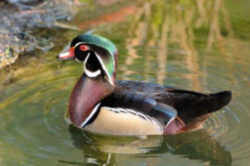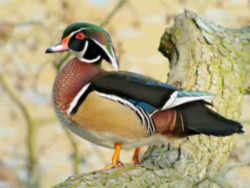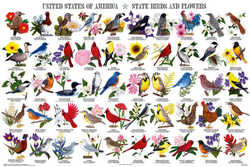
Mississippi Symbols
Mississippi State Waterfowl
Wood Duck
or Carolina Duck
(Aix sponsa)
Adopted on April 12, 1974 .
The Wood Duck, (Aix sponsa,) was designated the State Waterfowl of Mississippi, Chapter 551, General Laws of Mississippi of 1974.
Mississippi boasts more than a million acres of prime game habitat in 36 state wildlife management areas and National Wildlife Refuges open for public hunting, including marshy waterfowl havens. The Wood Duck or Carolina Duck (Aix sponsa) is a medium-sized perching duck. A typical adult is about 19 inches in length with an average wingspan of 29 inches, and tend to inhabit fresh water ponds, lakes, wooded bottomlands, streams, and other wetlands.
Mississippi State Waterfowl: Wood Duck

The Wood Ducks or Carolina Ducks are small to medium sized birds. Both male and female adults have a crest on their head, a rectangular shaped tail, white bellies and white lines on the back of the wings. Males are 48 to 54 cm long, while females are 47 to 51 cm long. Their wingspans are 70 to 73 cm long and they weigh between 500 and 700 g. The sexes are dimorphic. The males' heads are iridescent green, blue and purple and have two white lines that are parallel and run from the base of the bill and behind the eye to the back of the head. Male wood ducks also have red eyes, red at the base of the bill, rust-colored chests, bronze sides and black backs and tails. The females are brownish to gray and have white eye rings, white throats and gray chests. Juvenile wood ducks resemble adult females. Wood ducks are sometimes mistaken for American widgeons (Anas americana) when flying because the white lines that wood ducks have at the back of their wings are not visible. Also female wood ducks are mistaken for female Mandarin ducks (Aix galericulata). The difference lies in the Mandarin duck's lighter gray head and less distinctive eye patch.
Characteristics of the Wood Duck
Habitat
Wood ducks occupy a wide variety of habitats including woodland areas along lakes, rivers, creeks, beaver and farm ponds and various other freshwater vegetated wetland areas. Because wood ducks are cavity nesters, the availability of nesting sites within one mile of water is necessary. Winter habitats are the same as those used during breeding.Lifespan
The average lifespan of A. sponsa is three or four years. The maximum recorded lifespan in the wild is roughly 15 years. Within the first two weeks after hatching 86 to 90% of the chicks die. One cause of mortality is predation. Hunting also accounts for some mortality, however, hunting pressures are not enough to endanger the species.
Mississippi Statute
The law designating the Wood Duck as the official Mississippi state waterfowl is (Section 3-3-25. State waterfowl.) of the Mississippi Code, specifically Title 3 (STATE SOVEREIGNTY, JURISDICTION AND HOLIDAYS) Chapter 3 (STATE BOUNDARIES, HOLIDAYS, AND STATE EMBLEMS) Section 3-3-25.
TITLE 3. STATE SOVEREIGNTY, JURISDICTION AND HOLIDAYS.
CHAPTER 3. STATE BOUNDARIES, HOLIDAYS, AND STATE EMBLEMS.
SECTION 3-3-25.
§ 3-3-25. State waterfowl.
The wood duck (Aix sponsa) is hereby designated the state waterfowl of Mississippi.
Sources: Laws, 1974, ch. 551, § 5, eff from and after passage (approved April 12, 1974).
Taxonomic Hierarchy: Wood Duck
Kingdom Animalia - animals
Phylum: Chordata - chordates
Subphylum: Vertebrata - vertebrates
Class: Aves - birds
Order: Anseriformes
Family: Anatidae
Genus: Aix
Species: Aix sponsa







